By Kim Wilson, UC Master Gardener
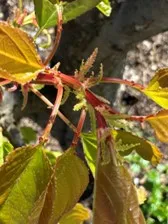 | A gardener finds small red bumps on the leaf petioles of her apricot tree. She shows this image to her Facebook gardening group. They identify the problem as red mites on this apricot tree. She decides to consult helpline before using an insecticide. Our helpline identified this as extrafloral nectaries. Extrafloral nectaries are normal structures of nectar glands on non-flower parts of plants. Often seen on cherry and apricot trees along many other plants. They serve as sources of nectar for insects. Caution: Diagnosis through consensus needs to be verified using credible science based sources. |
Brown tear staining of lemon identified by using google images as Anthracnose. Anthracnose and Septoria fungal spores do stain the surface of citrus but those stains cannot be washed off. Helpline knew it is important to see the specimen and demonstrated that the stains were easily washed off. On questioning, the client revealed spraying of nearby deciduous fruit trees with horticultual oil during cool late winter. Diagnosis- Staining of fruit by overspray of horticultural oil. Caution: Images often do not provide enough information for correct diagnosis. | 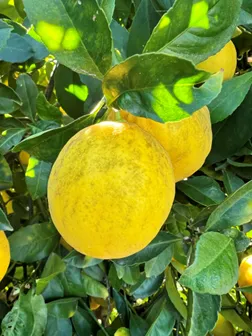 |
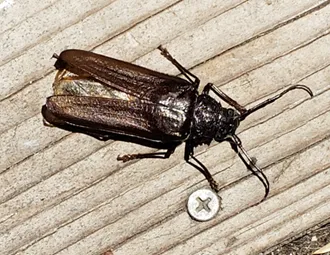 | A helpline client identified this insect as a Paloverde beetle by using an insect ID App. The larvae of this beetle feeds on roots of trees including olive. The client believed it was causing damage to her olive tree.
An entomologist serving as a Master Gardener helpline volunteer identified it as a look a like insect, Trichocnemis spiculatus, the Ponderous Borer Beetle whose larvae feed on dead or dying conifers. The client stated there was a stand of pines slowly dying and being removed nearby. The insect poses no risk to her olive tree.
Caution: Apps are often East coast centered identifiying pests that do not occur in California |
Cient has a Sapote tree that shows changes of yellowing and spotting of the leaves in the early spring. She indicated she had found a YouTube video advocating a homemade mixture of soap and peroxide for black spots of unknown origin on a Sapote tree. Should she use that recipe? What are the credentials of the YouTube speaker?
First, it is always critical to have a diagnosis before deciding a course of action. There were no pests or evidence of an infection. This tree is located in a borderline climate zone and the tenative diagnosis is cold damage. Advice to protect the tree from cold injury in future and follow up with any changes and future results.
Important lessons:always have a diagnosis before resorting to treatment. Don’t rely on advice from YouTube videos from non crdible sources. Some pests and diseases do not require treatment. Homemade or broad spectrum pesticides can cause harm to plant and environment. | 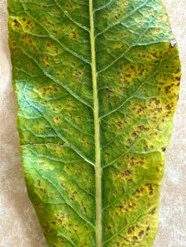 |
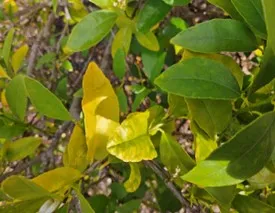 | Wekiwa citrus tree with curled and yellow leaves, client identified as effects of citrus chlorotic dwarf virus via an internet search. The problem is that disease only occurs in Turkey and some parts of China and Thailand.
Yellow citrus leaves are common in citrus and have multiple possible causes: overwatering, root dysfunction and nutrient deficiences.
Caution: Consult credible sources to verify any internet search results. |
How can we evaluate information and advice from the internet and other online sources. We have adapated the acronym developed by Linda Chalker-Scott, WSU Extension Horticulturist, to evaluate information.
CARP anaylsis: Does the information seem fishy?
Credibility- What are the credentials of the author or information source? Are the credentials in the field of interest; insects, plant and soil science?
Accuracy- Is the information objective and science based? Is the information recent.
Relevance- Is the information based on science of agricultural intensive monoculture setting or home garden and landscape? Is information pertinent to our state or county?
Purpose- Is the goal of the information to educate or to sell a product or service?
In your search for information, always verify with resources that pass the CARP test.
Resource options to use:
- UC ANR- University of California Agriculture and Natural Resources- Blog and a vast array of informative articles on horicultural topics. Topics in Subtropics - Agriculture and Natural Resources Blogs (ucanr.edu)
- UC IPM- UC Statewide Integrated Pest Management Program- provides pest notes on management of pests with minimizing harm to people and the environment.
- Home Page - UC Statewide IPM Program (ucanr.edu)
- UC Master Gardeners of San Luis Obispo- Website, YouTubes, info docs and our helplines. Master Gardeners of San Luis Obispo County, California Serving Our Community Since 1996 (ucanr.edu)
- Non-California University, university extension websites are also excellent resources but make sure information is pertinent to California. UC Master Gardeners from other counties are also excellent resource.
- State agricultural offices, CalFire, and reputable science-based sources specific to your geographic region.
